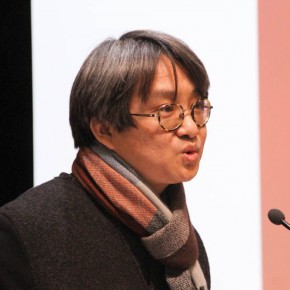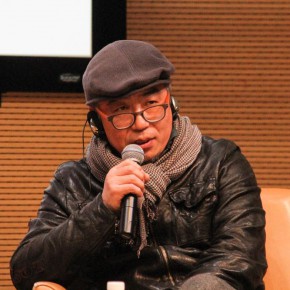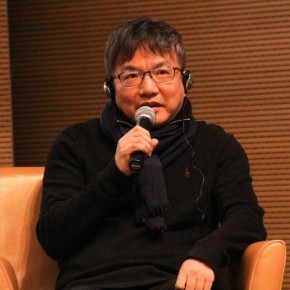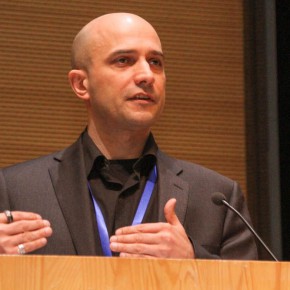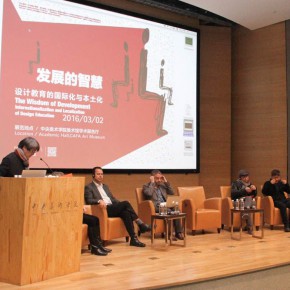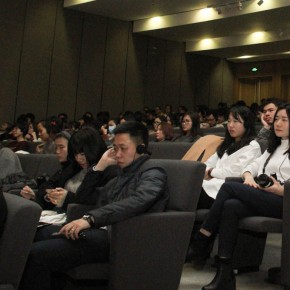
On the afternoon of March 2, 2016, the second half of “The Wisdom of Development – Globalization and Localization of Design Education Forum II”, hosted by Director of Art Museum of Beijing Fine Art Academy Wu Hongliang, was held in the Auditorium of CAFA Art Museum. The afternoon forum was divided into three parts: in the first section, the honored guests were invited to express opinions on the theme of the “diversified design education and the conversion of achievements”; in the second part, Peter William Barker, Department Head of Kolding Design School, Denmark and Raz Barfield, Deputy Dean of the College of Art and Multimedia at the University of Salford, UK respectively gave a keynote speech; in the final section, the honored guests unfolded a discussion around “the relationship between traditional handicraft and contemporary design”.
Discussion: Diversified design education and the conversion of achievements
The honored guests participating in the first part included Halina Kosciukiewicz, a professor from Akademia Sztuk Pi?knych w Gdańsku, Poland, Naren Barfield, Vice President of the Royal Academy of Art, UK, Peter William Barker, Department Head of Kolding Design School, Denmark, Song Xiewei, Deputy Dean of the School of Design, CAFA, and Huang Jiancheng, Deputy Dean of the School of Urban Design, CAFA.
First of all, the host Wu Hongliang questioned how the students transformed the knowledge received in the school into practical ability, so as to achieve true independence in society? Naren Barfield believed that the school curriculum should not only pay attention to students’ professional ability, and it should also pay attention to their cooperation with the industries, at the same time, they ought not to give students too many restrictions, fetters and limitations, allowing them to make a judgment; Halina Kosciukiewicz said that, the Akademia Sztuk Pi?knych w Gdańsku, Poland helped students to strengthen the association between students and other industries, so that they were more familiar with the market, and more quickly merged into society; Peter William Barker said that, Kolding Design School in Denmark had built a “professional studio”, which was able to help students contact with a potential employer before their graduation. Huang Jiancheng, Deputy Dean of the School of Urban Design, CAFA talked about his planned “Fantastic Art China” project in New York. Design education advocated the development of multi-knowledge points, and the multi-knowledge structure project under the background of college, starting from practice to find, to ask and to solve the problem. “Fantastic Art China” was the study of the cultural blend and cultural inheritance. In the process of the project, the students also received a vital practical exercise, which was also part of the teaching system. As the Deputy Dean of the School of Design, CAFA, Song Xiewei pointed out that, “Observed from the perspective of design education, our design is located in a backward state.” It is influenced by globalization, with new technology entering, people’s values and ideology has changed. “But our understanding of the design still belongs to the category of physics – the use of the perspective of physics to understand the features of the product.” Song Xiewei said the designer does not pay attention to the product attributes but focuses on design methods.
Keynote speech: Peter William Barker & Raz Barfield
Peter William Barker, Head of the Department of Industrial Design at Kolding Design School in Denmark, made a keynote speech. He said that, although Denmark was a small country, it had a long history of design and many outstanding designers emerged. Then, he had a detailed introduction of Kolding Design School, Denmark, in addition to the conventional academy courses, Kolding Design School paid attention to the cooperation with enterprises, to set up the scientific research and the laboratory of design, paid attention to international exchanges, with the students from all over the world, and every student had an opportunity to go abroad to communicate when they studied in the school. In terms of design education, it pays attention to the students’ self-management and the cultivation of students’ ability for group cooperation, so that the student can feel an uncontrolled and equal learning atmosphere.
Raz Barfield, Deputy Dean of the College of Art and Multimedia at the University of Salford, UK, used his own experience to discuss the difference between China and UK in terms of design. He said that, Chinese students’ skills were better than British students, but the British students always had relatively novel design ideas; in terms of product design, Chinese students paid more attention to the cheap degree of commodity while Britain students focused on the perfect degree of commodity; Chinese students paid more attention to results rather than the process, and so on. When it came to the “Design for Sitting” exhibition, Raz Barfield said that, he had found a lot of creative designs in the exhibition, he said that, “Creating way is constantly evolving, in the practice of handicraft production and design thinking, we must have a very good fusion.”
Discussion: Relationship between traditional handicraft and contemporary design
Raz Barfield, Deputy Dean of the College of Art and Multimedia at University of Salford, UK, Peter William Barker, Head of the Department of Industrial Design at Kolding Design School, Denmark, Prof. Shi Zhenyu from Academy of Arts & Design, Tsinghua University, Prof. Zhang Nairen from the Beijing Institute of Technology, and Prof. Jiang Li from the School of Design, CAFA were present at the final discussion.
Raz Barfield believed that it was necessary to consider the “soul” of the product in the design, starting from the perspective of the product, to explore the intrinsic value by its texture, material qualitative and craft. The maximum value of handicrafts is the “soul”, Raz Barfield said that, “We all have our computers, intelligent phones, which are useful, but they don’t have a personality and connotation, they belong to anyone that takes them, so you can’t fall in love with it.”
Peter William Barker analyzed the differences and relations between craftsmen and designers, and he believed that, craftsmen had a natural reverence for the materials, and they had a more in-depth grasp on material. Viewed from this perspective, Barker said, “We hope that designers will pay more attention to qualitative materials, to learn the spirit of the craftsmen.”
Shi Zhenyu said that, when one made design in the contemporary, it was necessary for him to “offer the right people the right products at the right time”. What kind of products do modern people need? It requires designers starting from “people”, instead of “things”. Shi Zhenyu spoke straightforwardly, “Many designers have a misunderstanding.” For example, rather than excessively pursuing crafts in furniture itself, they consider how to achieve the most comfortable state in the process of using furniture. Shi said that, “How do the people born in the 1980s and 1990s live? As long as we study these factors, our furniture can achieve innovation, because we offer furniture to these people.”
Zhang Nairen continued with the previous topic, he said, the design of the furniture was closely related to people’s life background, habits and ways. “As long as one can comfortably, happily sit, playing on the computer or watching TV, there is no limitation of the shaping of the style of the chair.”
Jiang Li issued the idea on the topic “How to convert the creative way of a traditional handicraft to modern design”. Jiang Li said that, “The creative way for the handicraft contains the time element or continues to the cultural inheritance.” Jiang Li said that, it was necessary to promote operational ability in the current teaching, to study the manufacturing style of people in the past. For the transformation of modern design, it is actually a study of the life of modern people, Jiang said, “It is necessary to study from humans, to study from the social formation, we will give it the things that social formation needs.”
Text by Lin Jiabin, Photo by Hu Sichen/CAFA ART INFO
Translated by Chen Peihua and edited by Sue/CAFA ART INFO


